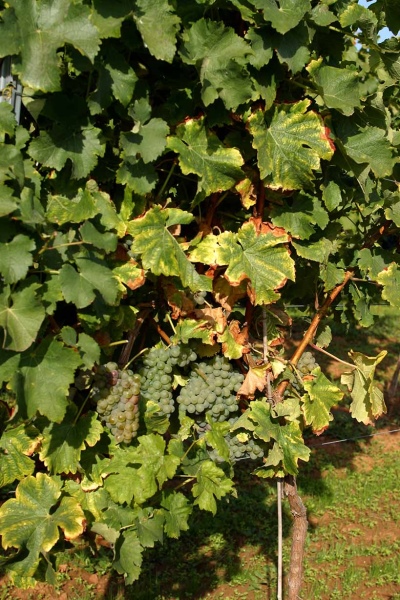
- Authors: France
- Appointment: technical
- Berry color: greenish-white, yellowish-pink tan in the sun
- Taste: harmonious, nightshade
- With bones: Yes
- Ripening period: average
- Ripening period, days: 130-135
- Frost resistance, ° C: -22
- Name synonyms: Blanc fumé, Bordeaux bianco, Genetin, Gros Sauvignon, White Sauvignon, Small Sauternes, Sylvaner Muscat, Pellegrina, Petit Sauvignon.
- Bunch weight, g: 75-120
Sauvignon Blanc is one of those varieties that are cultivated all over the world on an industrial scale, but this does not mean that it cannot be grown at home.
Breeding history
The names of the breeders who bred the grapes have not been established. The variety appeared in France, and from there it spread further. When crossing, the Traminer variety was used and another, which remains unknown to this day.
You can hear other names of the described variety - for example, Genetin, Muscat Silvaner and others.
Geography of distribution
The grapes in question are classified as Western European varieties. Today it can be found on every continent as it is the second most abundant white species. In the first place is Chardonnay.
The Loire Valley, which is located in France, is considered the birthplace of Sauvignon Blanc. This is an elite variety, which is grown with great success today in Italy, Austria, the Czech Republic and other countries.
Description
Sauvignon Blanc belongs to technical varieties. The grapes are used for the production of white wine.
The bushes are medium-sized, bisexual flowers appear on them. On the plant, the number of fruitful shoots is 37-80. One developed shoot accounts for 0.6 bunches, for a fruitful one - 1-1.2.
Ripening period
Ripening period is average, 130-135 days.
Bunches
When fully formed, the clusters acquire a cylindrical shape. Very dense, weighing from 75 to 120 grams.
Berries
The berries are greenish-white at first, but with enough sun they turn yellowish-pink. There are seeds, there are 2-3 pieces of them in each berry. The sugar level is 186-231 g / dm³. The acidity level is 6.4-11.1 g / dm³.
A distinctive feature is a dense skin. The pulp is very juicy. Each fruit has a round or slightly oval shape. The size can be 15-17 x 14-16 mm.
Taste
The grapes are prized for their harmonious nightshade taste. If we talk about wine, then it turns out with a specific, tart-sour aftertaste. Something like red currant or gooseberry in aroma.
Yield
The described variety does not differ in yield. You can increase the yield and at the same time not be afraid of overloading the bushes. This will require an increase in the number of fruitful shoots.


Growing features
Best of all, Sauvignon Blanc grows in the cool, where it acquires the necessary freshness of the aroma. If it grows in hot climates, then the fruits gain a lot of sugar, the wine turns out to be heavy. In the latter case, dessert drinks are made from berries.
The variety has special preferences for the type of soil. Heavy clay soil will not work; light to medium soils are best.The ideal solution is fertile humus-carbonate soil. The vine grows well on a slope, where groundwater is far from the surface.
Best rootstock:
- Berlandieri x Riparia CO4;
- Riparia x Rupestris 3309.
Landing
Depending on how you plan to place the one-year growth, a landing pattern is selected. If this is a high-stamped formation, assuming a free arrangement, then the 2.75-3 x 1.5 scheme is used.
The distance between the rows can be reduced if it is a vertical garter or low-stem bushes.

Pollination
There is no need for additional pollination, since the flowers on the grapes are bisexual.
Pruning
With standard pruning, 5-8 eyes are left on the bush. The best time for this is the end of autumn. As soon as the leaves fall, you can start working in two weeks.

Watering
Water the grapes only if there is not enough rain. A 10-liter bucket is enough for a bush.


Frost resistance and the need for shelter
When cultivating the described variety, it should be borne in mind that it does not differ in frost resistance. In temperate continental climates, shelter is required for the winter. The vine is not damaged at -22 ° C. If the buds die from frost, replacement buds grow in their place, but it is impossible to get a crop from them, since they are in most cases sterile.
As a shelter, multi-arm fans or oblique cordon are used. The vine is laid so that, when removed from the trellis, it is not damaged and buried in the ground.
Organic material is also perfect as insulation:
- straw;
- reed;
- shavings.
A layer of roofing material must be laid on top, you can use a film. The main thing is that the vine inside is dry and remains so until the shelter is removed.

Diseases and pests
The described variety must be fully treated against diseases and pests, since it has low resistance to them.
Especially often grapes are affected:
- gray rot;
- mildew;
- oidium.
To help the gardener - fungicides, the most common is copper sulfate.
Gray rot most often affects young plants. As a remedy for it, use "Fundazol", formalin.
Of the pests, the leaf roll is considered the most dangerous. Untimely processing will lead to the fact that the bushes will die, as the insect will eat the foliage. The fight is carried out by means of "Metaphos".
Wasps love grapes, this is one of the reasons why it is not worth thinning. Special traps are set for pests in the vineyard, sugar syrup is placed or the bunches are wrapped in a net.

If a grape is exposed to any disease or insect, this always affects its appearance.
Storage
Such grapes are not stored, they must either be eaten immediately or put into production. Transportation also spoils the fruit.











































































